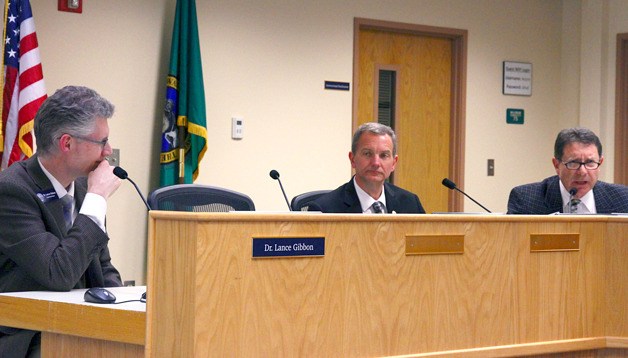The expansion of Naval Air Station Whidbey Island — already underway, and projected to increase dramatically by 2018 — poses a housing challenge to Oak Harbor, Mayor Bob Severns said while addressing an April 18 meeting of about 85 Realtors, developers and city and county officials.
“I would never call this a crisis,” he said. “I would call this an opportunity.”
The “opportunity” is to house 3,747 additional Oak Harbor residents by 2036, said Steve Powers, the city’s development services director.
The city’s population, including Navy personnel and their families, is projected to grow by that number to 25,822 in 2036, up from 22,075 in 2010.
Using 2016 as a baseline, the number of military and civilian personnel, plus their families, associated with NAS Whidbey is projected to increase by 1,320 people, or 7 percent, to 19,560 by 2018; and by 3,740 people, or 20 percent, to 21,980 by 2019, the Navy has said.
About 70 percent currently live in Oak Harbor, with Coupeville and Anacortes the next most popular cities, said Capt. Geoffrey Moore, the base’s commanding officer.
To accommodate the additional 3,747 people, Oak Harbor needs 1,629 more housing units, either apartments or houses, Powers said.
The city’s Urban Growth Area, land contiguous to the city limits, has enough space for those units, he said.
A considerable amount of new-home construction is currently, or about to be, under way, including:
Island Place, 66 single-family homes near the intersection of Northwest Heller Street and Northwest Crosby Avenue, under construction.
Marin Woods, 43 single-family homes off Southwest Swantown Avenue near the intersection with Fairway Lane, is in preliminary review.
Four projects are being considered, though no application has yet been submitted. They are:
The Garry Oak subdivision, at the intersection of Southwest 24th Avenue and State Highway 20, with 59 single-family homes;
Ely Terrace, at the intersection of Southeast Ely Street and Southeast Barrington Drive, with 30 townhouses;
Tanya Jean, at 300 Northeast Seventh Avenue, with five townhouses; and
AHA Investments, at 425 Southeast Barrington Drive, with 26 apartments.
Those developments, which will bring a total of 229 units if all are built, won’t be close to enough to meet the demand, Powers conceded. Ready to step in is Clayton Homes, a Maryville, Tenn. builder of manufactured and mobile homes.
“The city’s definitely facing a housing crunch, obviously,” said general manager Trevor Belch, who attended the meeting. “We are starting investigating what we can do to bring our product into this area.”
Clayton might start by buying up 4-5 lots and building on spec, Belch said.
“We can do entire subdivisions,” if the demand is there, he said.
Clayton Homes can build a dwelling in 12-13 weeks, Belch said. Permits are most often the hold-up. Clayton carries the cost of construction, so the buyer need only pay at the end.
Because the units are titled as real property, buyers may qualify for FHA, USDA or VA financing, Belch said.
The housing shortage is real, said Rick Chapman, president of real estate firm Coldwell Banker Tara Bayview, at the meeting. On a typical day recently, 110 houses were for sale and seven were for rent in the North Whidbey area, defined as the region between Libbey Road and Deception Pass Bridge.
Of those 110 houses, 52 cost under $400,000 — the top of the range most military families can afford, Chapman said.
Those numbers held steady over several days, he said.
The 52 houses represented a one-month supply at recent sales rates, he said.
“So coming here to find a house seven months before you get transferred here, that’s about what you need to do,” he said.
As for rentals, “we have zero vacancies,” he said. “Tenants notify us they’ll be moving out and we get new renters two weeks later, sight unseen.”
Rents on North Whidbey have increased an average of 25 percent, and in some cases up to 40 percent, over the past 2-1/2 years, “and they’re still going up,” he said.



